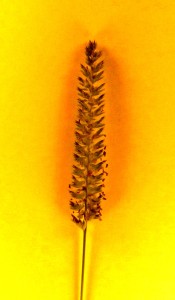 Dr M is particularly fond of grasses!
Dr M is particularly fond of grasses!
Grasses are an important group of plants with more than 10 000 species worldwide.
In Britain there are over 150 species of grasses and they are an important component of all habitat types not just grasslands (pastures, meadows), but also woodland, heathland and wetlands.
Grasses are important as food for grazing animals.
But grasses are also valuable as ecological indicators of environmental conditions e.g. of calcareous or acid soils, of wet or dry soils, saline soils, and of shady and open habitats.
Grasses also have an intrinsic beauty and fascination all their own, indeed, as Dr M has himself sung: “The Poaceae is a family of grasses green and wonderful!”
So for many reasons it is an important (as well as pleasurable) skill to be able to identify grasses.
But unfortunately, grasses are often viewed as a “difficult group”.
But Dr M says the identification of British grasses is not as difficult as many would have us believe!
However ID of grasses does require knowledge of some important characters of grasses both flowering and vegetative and the associated botanical terms.
Check our Dr M’s grass ID video here.
So while you wait for these, here is Dr M’s ABC of grass terms you need to learn to help you ID grasses:
Auricle Claw like outgrowths from the leaf blade extending various distances around the sheath.
Awn A stiff bristle situated at the back or tip of a glume or lemma (sometimes bent (geniculate) between the column and limb).
Blade The part of the leaf above the sheath often flat, sometimes folded, involute (margins rolled outwards) or convolute (rolled up longitudinally).
Culm The flowering stem of a grass (the culm has nodes qv.).
Floret A single small flower with lemma and palea (there may be one or several florets in a spikelet).
Glume The lowest two (sometimes one) empty scales subtending the usually fertile scales in grass spikelets. The outer glume is the lower and the inner glume is the upper.
Lemma The lower (outer) of the two scales forming the floret in a grass spikelet – the uppermost, less easily seen, is the palea.
Ligule An outgrowth, often membraneous, occasionally a fringe of hairs, at the junction of leaf sheath and blade.
Nerve A longitudinal vein or rib running along the centre of the grass blade.
Node The point along a grass flower stem (culm) which gives rise to leaves, branches, or inflorescences.
Palea The uppermost of the two scales forming the floret in a grass spikelet (often obscure or hidden) the other, the more visible one, is the lemma.
Panicle The inflorescence of the Poaceae, derived from a compound raceme, sometimes branched and spreading, sometimes much condensed and deceptively spike-like (although technically NEVER a true spike).
Rachis The axis of a panicle or raceme.
Ribbed Describing a leaf blade with pronounced raised nerves or ribs, corrugated in transverse section.
Sheath The lower part of the grass leaf surrounding the internode often fused into a tubular structure (pseudo-stem which occurs in all grasses but is most pronounced in the bamboos which are not native to Britain but which are widely planted in garden).
Spikelet The unit of the grass inflorescence comprising (usually) two glumes and the enclosed floret or florets.
Tiller Vegetative grass shoot.
BREAKING NEWS! Dr M has launched a series of blog posts on the Tribes of grasses, check out the first one on the Poeae and contact Dr M and let him know what you think!
